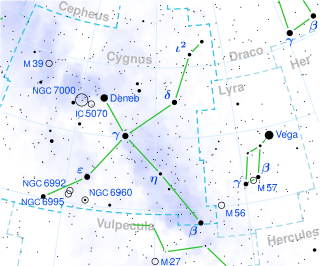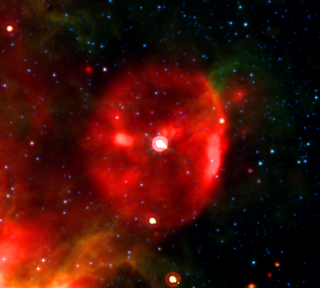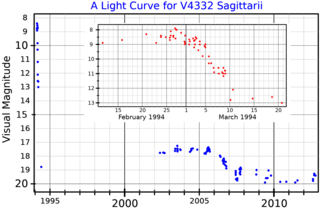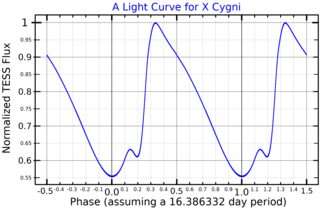
Chi Cygni is a Mira variable star in the constellation Cygnus, and also an S-type star. It is around 500 light years away.

V1500 Cygni or Nova Cygni 1975 was a bright nova occurring in 1975 in the constellation Cygnus. It had the second highest intrinsic brightness of any nova of the 20th century, exceeded only by CP Puppis in 1942.

T Coronae Borealis, nicknamed the Blaze star, is a recurrent nova in the constellation Corona Borealis. It was first discovered in outburst in 1866 by John Birmingham, although it had been observed earlier as a 10th magnitude star. It may have been observed in 1217 and in 1787 as well. It is expected to undergo an outburst again in 2024.

V476 Cygni or Nova Cygni 1920 was a nova which occurred in the constellation Cygnus in 1920. It was discovered by William Frederick Denning, an English amateur astronomer, at 09:30 GMT on 20 August 1920, at which time it had a magnitude of 3.7. It reached a peak brightness of magnitude 1.7 on 23 August 1920. Its quiescent brightness is magnitude 17.09.

V1668 Cygni was a nova that appeared in the northern constellation of Cygnus, situated a couple of degrees to the southeast of the star Rho Cygni. It was discovered by Canadian variable star observer Warren Morrison on September 10, 1978, and reached a peak brightness of around 6.22 apparent magnitude on September 12. The luminosity of the source at this time was about 100,000 times the brightness of the Sun, and likely remained at that level for several months. The expansion velocity of the nova shell was deduced through spectroscopy to be 1,300 km/s.

Sakurai's Object is a star in the constellation of Sagittarius. It is thought to have previously been a white dwarf that, as a result of a very late thermal pulse, swelled and became a red giant. It is located at the center of a planetary nebula and is believed to currently be in thermal instability and within its final shell helium flash phase.
Z Andromedae is a binary star system consisting of a red giant and a white dwarf. It is the prototype of a type of cataclysmic variable star known as symbiotic variable stars or simply Z Andromedae variables. The brightness of those stars vary over time, showing a quiescent, more stable phase and then an active one with a more pronounced variability and stronger brightening and/or dimming.
FG Sagittae is a supergiant star in the constellation Sagitta at a distance of 4000 light-years. When first noted in 1943, it was identified to be a variable star, and it was found to be a hot, blue star of stellar spectral type B in 1955. Since then it has expanded and cooled, becoming a yellow G-type star by 1991, and then further cooling to become an orange K-type star. It started to pulsate when becoming an A-type star with a period of 15 days. This period later increased to over 100 days.

WZ Sagittae is a cataclysmic dwarf nova star system in the constellation Sagitta. It consists of a white dwarf primary being orbited by a low mass companion. The white dwarf is about 0.85 solar masses while the companion is only 0.08 solar masses. This implies that the companion is a spectral class L2 star, although this has yet to be confirmed. The distance to this system has been determined by parallax, yielding a distance of 45.1 parsecs.

Cygnus OB2 is an OB association that is home to some of the most massive and most luminous stars known, including suspected Luminous blue variable Cyg OB2 #12. It also includes one of the largest known stars, NML Cygni. The region is embedded within a wider one of star formation known as Cygnus X, which is one of the most luminous objects in the sky at radio wavelengths. The region is approximately 1,570 parsecs from Earth in the constellation of Cygnus.

NML Cygni or V1489 Cygni is a red hypergiant or red supergiant (RSG) in the constellation Cygnus. It is possibly one of the largest known stars currently known, and is also possibly one of the most luminous and massive cool hypergiants, as well as one of the most luminous stars in the Milky Way.

HDE 316285 is a blue supergiant star in the constellation Sagittarius. It is a candidate luminous blue variable and lies about 6,000 light years away in the direction of the Galactic Center.

CH Cygni is a red giant, variable, symbiotic binary in the constellation Cygnus. It is the nearest symbiotic star to Earth, and one of the brightest, making it an ideal candidate for study.

V1794 Cygni is a single variable star in the northern constellation Cygnus. It has the identifier HD 199178 from the Henry Draper Catalogue; V1794 Cygni is its variable star designation. With an apparent visual magnitude of 7.24, it's too dim to be visible with the naked eye but can be seen with binoculars. V1794 is located at a distance of 367 light-years (113 pc) based on parallax measurements, but is drifting closer to the Sun with a radial velocity of −31 km/s. It lies superimposed over a region of faint nebulosity to the west of the North American Nebula.

V4332 Sagittarii is a nova-like event in the constellation of Sagittarius. It was discovered February 24, 1994 at an apparent visual magnitude of 8.9 by Japanese amateur astronomer Minoru Yamamoto from Okazaki, Aichi, then confirmed by K. Hirosawa. Initially designated Nova Sagittarii 1994 #1, it was given the variable star designation V4332 Sgr. A spectra of the event taken March 4 lacked the characteristic features of a classical nova, with the only emission lines being of the Balmer series. Subsequent spectra showed a rapid decline in luminosity and a change of spectral type over a period of five days. By 2003, the object was ~1500 times less luminous than at peak magnitude and showed a spectrum of an M-type star.

U Sagittae is an eclipsing binary star system in the northern constellation of Sagitta. It has been actively studied since its discovery in 1901. The maximum apparent visual magnitude of this system is 6.50, which is near the lower limit of visibility to the naked eye. The system is located at a distance of approximately 868 light years from the Sun based on parallax measurements, but is drifting closer with a radial velocity of −17 km/s. It is positioned about 2° from the middle of the Collinder 399 asterism, but lies much further away than the purported member stars.

PU Vulpeculae is a very slowly evolving symbiotic nova in the northern constellation of Vulpecula, abbreviated PU Vul. It is too faint to be visible to the naked eye, reaching a maximum apparent visual magnitude of 8.7 following a minimum of 16.6. The system is located at a distance of approximately 17,000 light years from the Sun based on parallax measurements.

X Cygni is a variable star in the northern constellation of Cygnus, abbreviated X Cyg. This is a Delta Cephei variable that ranges in brightness from an apparent visual magnitude of 5.85 down to 6.91 with a period of 16.386332 days. At it brightest, this star is dimly visible to the naked eye. The distance to this star is approximately 628 light years based on parallax measurements. It is drifting further away with a radial velocity of 8.1 km/s. This star is a likely member of the open cluster Ruprecht 173.

SU Cygni is a triple star system in the northern constellation of Cygnus, abbreviated SU Cyg. The primary component of the system is a classical Cepheid variable with a period of 3.8455473 days. The changing luminosity of this star causes the system to vary in brightness from a peak apparent visual magnitude of 6.44 down to magnitude 7.22 over the course of its cycle. The distance to this system is approximately 3,200 light years based on parallax measurements. It is a member of the Turner 9 open cluster of stars.

4 Draconis, also known as HR 4765 and CQ Draconis, is a star about 570 light years from the Earth, in the constellation Draco. It is a 5th magnitude star, so it will be faintly visible to the naked eye of an observer far from city lights. It is a variable star, whose brightness varies slightly from 4.90 to 5.12 over a period of 4.66 years.

















